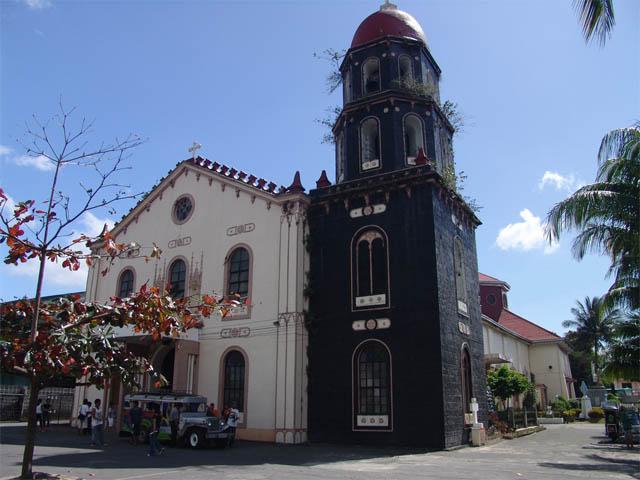
In its long and colorful history, the Guinobatan Church has stood over the town and its inhabitants as a center of faith and home to the Our Lady of the Assumption. Despite the ravages of time, it has been rebuilt and restored by the townsfolk who hold it dear and close to their hearts as an irreplaceable legacy.
In 1672, the Parish of Guiinobatan has already been mentioned in books as a “visita” of the Municipality of Camalig. In 1678, Don Francisco Bamasbad, chief of the “tenientes absolutos”, spearheaded the elevation of a petition to the Governor-General through the Franciscan Missionaries that the settlement, then a part of Camalig town, be declared an independent municipality. After ten years, (1678-1688) the request was granted. By virtue of Don Francisco Bagamasbad’s initiative, he was appointed “Gobernadorcillo” and recognized as the first civil administrator of the new Municipality of Guinobatan. Thus, Don Francisco Bamasbad was considered as the founder of Guinobatan.
Rev. Fr. Alfonso de Zafra was assigned as the first minister of the newly separated Parish of Guinobatan. The town’s Patroness (from 1688 to the present) is the Our Lady of the Assumption, whose Feast falls on the 15th of August. Hence, Guinobatan will have its 318th Fiesta Celebration on August 15, 2006, with the local parish and religious organizations planning for the Guinobatan Church’s Centennial Anniversary on December 08, 2006. then, it was in February, 1814 when the church was entirely destroyed for the first time due to the boulders and burning lava from the destructive eruption of Mayon Volcano. A temporary church was then built in Barrio Mauraro, which eventually became the center of the parish. Due to constant threats of the Mayon eruptions, the parish again transferred to the shores of Panganiran (now a part of Pioduran town by virtue of RA3817 enacted in 1965). Later, the Guinobateños broke camp and returned to Guinobatan to suffer again the destructive eruption of the volcano.
In 1863, the church under the advocation of the Assumption of our lady, was of good structure and so likewise was the parochial house. There were two “ermitas” both of them dedicated to Saint Vincesnt. It has royal house of stone, half-ruined, a school for primary instruction endowed by the funds of the community and a school for girls funded by the charity of its Parish Priest Rev. Fr. Bernardino Melendreras. The state of the parish at the time has the pertinent data: a) Tributes – 4,067 and b) Souls – 15,566. In 1938, the Parish of Guinobatan had a land area of 29,564 hectares and a population of 31,048 with a Bicolano Parish Priest, Rev. Fr. Carlos Badiola.

Church Interior
Rebuilding the Church of Guinobatan
Out of the havoc of war and natural calamities, Msgr. Julian O. Ope, was determined to reconstruct the burned church of Guinobatan. As he viewed one morning the vast ruins of the Colegio de San Buenaventrua and the church and as far as the ruins of San 9Rafael, Msgr. Ope’s desire to rebuild the church of Guinobatan was firmly developed in him. Msgr. Ope then, religiously and constantly appealed to his fellow Guinobateños for patience and perseverance in the reconstruction work of the church. The Guinobateños, considering the deep and solid foundations of the culture and Catholic religion engrained in their hearts, which Spain had left as a legacy to them, unanimously rallied behind Msgr. Ope’s project of rebuilding the church. It was said that every member of the families in Guinobatan, be they children and adults were seen in long lives to the direction of the church site bringing stones, bricks, sand and other building materials they could freely contribute for the reconstruction of the church.
However, all the rest of the materials were provided by Msgr. Julian O. Ope out of his own funds and that of his brothers’ and parents’ property, just to bring the reconstruction of the church to completion. It was also revealed that most of the Ope family’s property was exhausted for the reconstruction of the Guinobatan Church.
List of accommodations around Albay
- ALICIA HOTEL - F. Aquende Drive, Albay District, Legazpi City
- CASA EUGENIA HOTEL & RESTAURANT -- Tagas, Tabaco City
- HOTEL CASABLANCA - Peñaranda Ext., Legazpi City
- HOTEL LA TRINIDAD - Rizal St., Legazpi City
- HOTEL VENEZIA - Renaissance Gardens, Washington Drive, Legazpi City
- PEPPERLAND HOTEL - Airport Road, Legazpi City
- JENNIFER’S GARDEN APARTELLE - J. Estevez St., Albay Dist., Legazpi City
- HOTEL VICTORIA - Rizal St., Legazpi City
- AVENROSE SUITES - Washington Drive, Legazpi City
- CLIFFSTONE INN - Lidong, Sto. Domingo, Albay
- IBALONG TRAVELERS HOSTEL - BDB Bank Bldg, 210 J.P Rizal St
- DIVINE TOURIST INN - A. Luna St., Divino Rostro, Tabaco
- NEUHAUS TOURIST INN - Magayon Dr., Daraga, Albay
- SAMBITAN TOURIST INN - Diversion Road, Ligao, Albay
Transportation
Air Transport
By air, Legazpi City is 45 minutes away from Manila via the nation’s flag carrier, Philippine Airlines.
Land Transport
By land, aircon tourist bus companies ply the Manila-Legazpi route daily with an average travel time of nine hours. The average travel time by train is sixteen hours via the Philippine National Railway, the country’s sole rail transportation service.
Sea Transport
Several shipping lines have regular trips to and from Catanduanes through the Tabaco Port. Travel time from Visayas and Mindanao pass through the port of Matnog in Sorsogon.
Getting around the city
Buses and jeepneys are generally the modes of transportation in getting around Albay's destinations. Pedicabs and tricycles are also available for short distance travels. Taxis and rent-a-car services are also available.










